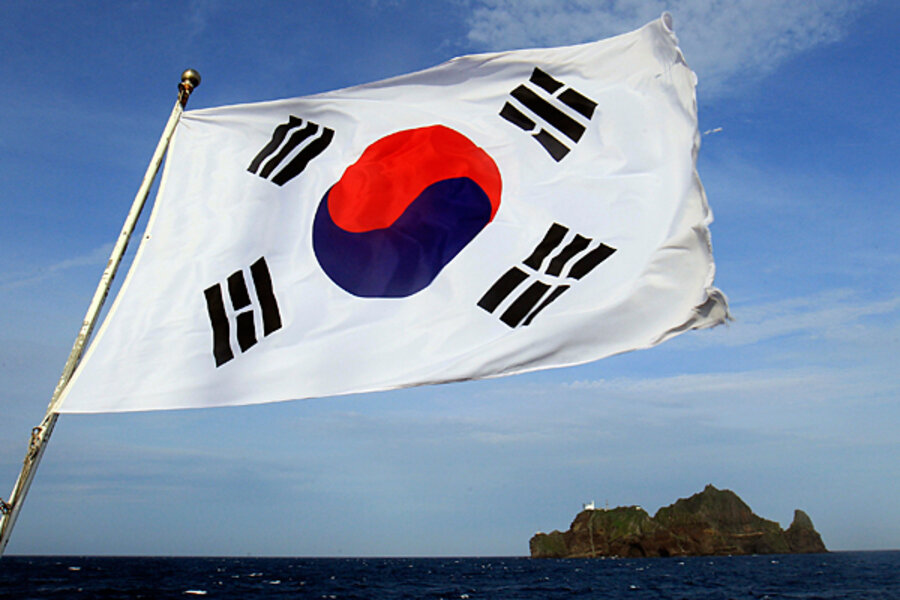Island dispute, 'comfort woman' statue put edge on Japan-South Korea ties
Loading...
| Seoul, South Korea
Diplomats at the Japanese embassy here can hardly decide what’s more troublesome, nonstop quarreling over a pair of rocky islets between mainland South Korea and Japan or the furor surrounding a statue of a woman opposite the Japanese embassy.
“The Korean government says there is no territorial problem,” says Masato Suzuki, who has worked at the Japanese embassy here for three years, “but Japan has stressed there is a problem.”
The problem revolves, as it has since the Japanese surrender in 1945, around the islets that Koreans call Dokdo and the Japanese call Takeshima, in waters the Koreans call the East Sea and the Japanese the Sea of Japan. A South Korean garrison holds the islets, rocky promontories where no one lives permanently, where there’s no arable land, and where no boats are regularly moored.
The fact that the islets are basically useless, however, does not appear to be much of a consideration in exchanges of claims and counter-claims that threaten what had in recent years been an improving relationship between Japan and South Korea.
Japan’s Prime Minister Yoshihiko Noda sent a letter proposing to have the case adjudicated before the International Court of Justice. South Korea, however, has not only rejected that idea but has refused to accept Mr. Noda’s letter – and returned it by registered mail after Japan’s foreign ministry refused to take it from a Korean diplomat who sought to return it in person.
‘It’s an embarrassment’
For the US, which nurtures military alliances with both countries, the standoff poses a foreign policy dilemma that worsened this month when Korea's President Lee Myung-bak, seeking to improve sagging popularity ratings, visited Dokdo and called on Japan's Emperor Akihito to apologize for all the wrongs of Japanese colonialism.
"It's a very delicate problem for the US," says David Straub at the Korean Studies Center at Stanford University. "They are both allies and friends, but the US doesn't have influence."
The dispute has broader military implications that distract from common defenses against North Korea. Although Japan and South Korea are not threatening to go to war over the issue, South Korea stages military exercises around the islands that are clearly directed against Japan.
"From an American point of view, it's an embarrassment," says Mr. Straub, a former senior US diplomat here. Other than stressing the need for both sides to get along with one another, he says, "there's nothing that can be done."
Epitome of emotion
In fact, the dispute over the islets reflects deep resentments from the long history of the Japanese invasion of the Korean peninsula more than 500 years ago right down to the Japanese colonial occupation from 1910 to the end of World War II. The exploitation of thousands of young Korean women forced into sexual slavery for Japanese soldiers during World War II epitomizes the emotion behind the two nations’ relationship.
Koreans see the bronze statue of a pensive young woman situated across from Japan's embassy as a needed reminder of Japan’s refusal to compensate surviving “comfort women,” as they were dubbed, for the suffering they endured serving Japanese soldiers more than 60 years ago.
“The statue is very controversial,” says Mr. Suzuki. “The Japanese government position is it has to be removed quickly. It harms the dignity of the embassy.”
As of now, however, the chances of removal of the statue appear about as dim as those for South Korea giving up its hold on Dokdo.
“This is our territory,” says a spokesman for South Korea’s foreign ministry. “I don’t think we will remove that statue.”
Fresh flowers are strewn daily around the statue of the woman, a figure seated in a chair, garbed in traditional Korean hanbok, her hair cut straight and short, in the style of the proper young lady of the period, a bird of peace on her shoulder. On Monday, someone had placed a pair of new slippers beside the woman’s bronze bare feet. On cold winter days, passers-by have deposited scarves and boots – occasionally swathing the statue in blankets.
Beside the statue a plaque embedded in the sidewalk marks the day, Dec. 14, 2011, when the statue was placed there – the “1,000th Wednesday,” says the plaque, on which diminishing numbers of one-time "comfort women" demonstrated outside the embassy.
Japan’s take
Japanese aren’t sympathetic: They believe Korea’s claims to Dokdo are bogus and the emotional message of the “comfort women” vastly distorted.
“They try to overwhelm us with statements,” says Masashi Nishihara, president of the Research Institute for Peace and Security in Tokyo. As far as the Dokdo/Takeshima issue is concerned, he predicts “nothing will happen” though “tensions will decline” as memories fade of South Korea President Lee Myung-bak’s visit to the islets on Aug. 10.
As for the statue of the comfort woman, he says, “By putting [up] a statue like that, it downgrades the quality of the Korean people.”
That’s a view that angers Koreans immensely.
“The statue of course should stay,” says Seo Dong-sun, who works in a nearby office and stops to look at it almost every day. “The Japanese have to be reminded of the terrible things they did in the past. It’s quite a sad story.”
The other side of the story
Many people, both in Korea and Japan, take a broader view.
A Korean official, speaking on condition of anonymity, says he doubts if the differences will put a crimp in burgeoning trade and cultural relations, which have grown steadily since bans on Japanese movies and recordings ended more than a decade ago.
A Japanese official agrees.
“The present bad relations between our two countries will bring nothing but damage to both,” says the official. “We are closely related and dependent on each other, economically and culturally.”
The current standoff, she says, is “a great shame.”





